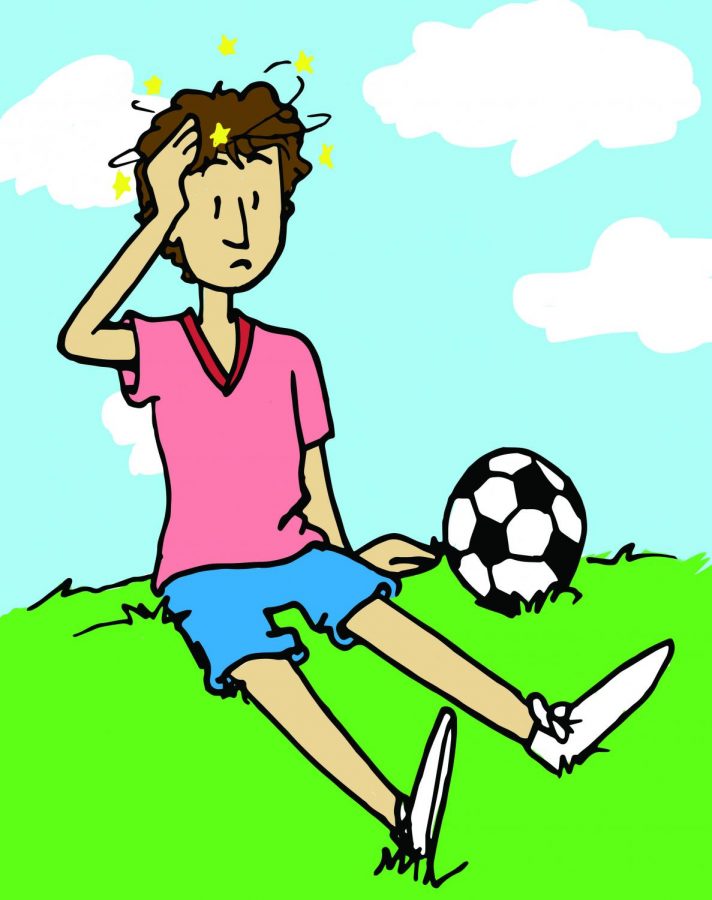Research reveals flaw in concussion recovery
Concussion
September 15, 2014
While concussions remain among the most common injuries sustained by high school athletes, little is known about the recovery process. A recent study from the University of Oregon found that high school athletes who are medically cleared to return to the field within 60 days of suffering a concussion often experience a significant decline in their abilities to simultaneously walk and perform simple mental tasks.
The study followed 13 football players, four soccer players, a volleyball player and a wrestler. Among the regressions that athletes experienced was a change in balance and/or altered walking speed, which was found to have occurred in 12 of the 19 athletes, according to the study. Of the 12 athletes, 10 had returned to activity in less than a month.
The seven athletes who did not experience these regressions performed similarly to uninjured control subjects and returned to action more than 20 days after their injuries. Athletes were assessed at five different points: within 72 hours, one week, two weeks, a month and two months post-injury, according to the study.
Li-Shan Chou, professor in the U of O Department of Human Physiology, said the study was not aimed at setting a new timetable but rather assessing athletes with concussions in the best possible way.
“Our focus was really on if you do suffer a concussion, how do we find the best way to evaluate the athlete’s recovery?” Chou said. “We can make sure that when they are allowed to return to activity they are in the best shape they can possibly be in.”
Concussion awareness has increased in recent years, with every state and the District of Columbia passing laws or amendments between 2009–2013, to change protocol for athletes who suffered concussions in high school sports, according to the Centers for Disease Control and Prevention.
Despite the policies already in place, Jeffrey Mjaanes, a sports medicine physician at Chicago’s Rush University Medical Center, said one of the main problems in treating concussions is that athletes are taking more risks as the equipment they use continues to improve.
“You build a better helmet and better equipment, and kids feel more invincible,” Mjaanes said. “They come out, and they hit harder and that’s part of the problem.”
According to the CDC, most states’ concussion laws require that athletes cannot return to play until after at least 24 hours of recovery and permission from a healthcare professional has been received.
Mjaanes said the problem is that doctors have to rely on their patients’ self-evaluations.
“Right now, we still largely rely on the athlete to tell us if they are having symptoms,” Mjaanes said. “If an athlete tells us that they aren’t having symptoms, we do the tests that we have, to try to ascertain, to the best of our ability, if that athlete is giving us correct information. And if they seem to be back at their baseline, we clear them to go back.”
USA Football’s Heads Up program, one of the largest programs advocating for safer play, has seen more than 750 high schools spanning across 44 states register for their program this season for coaching education, stronger fundamentals and safer play, according to Steve Alic, USA Football spokesman. Alic also said that players should not be rushed back from injury.
“We emphasize the CDC’s direction,” Alic said. “When in doubt, sit them out. If an athlete is even suspected of having a concussion, that player should be removed from play immediately. That awareness is happening, and there’s more work to be done.”
Mjaanes echoed those sentiments, saying that the timetable for concussion recovery could change as new technology in the medical field continues to be introduced.
“I think as new technology comes about, we might find that athletes are not recovering from concussions as fast as we thought,” Mjaanes said. “If that is the case, the timetable will need to be changed.”
Mjaanes also said that not everything should be changed based on one study, but that more studies need to be done.
“As of right now, we’re still kind of limited in what we can do [to treat concussions],”Mjaanes said. “I don’t think that we should change everything based on [U of O’s] study—we need more studies—but if they keep confirming this same fact [about regression], then we do need to change the timetable on [when athletes should] return to play.”








